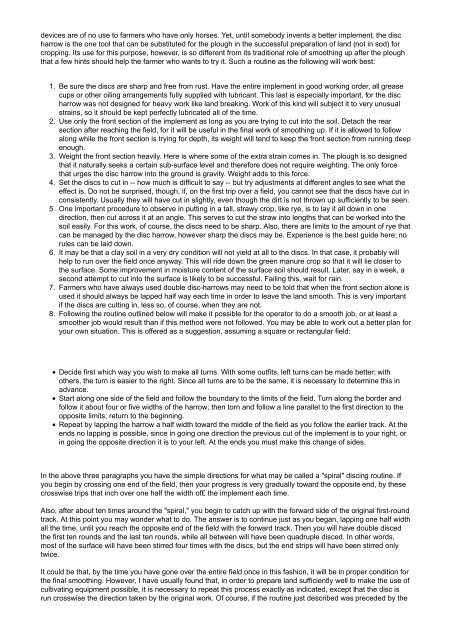Ploughman's Folly Ploughman's Folly - EcoPort
Ploughman's Folly Ploughman's Folly - EcoPort
Ploughman's Folly Ploughman's Folly - EcoPort
You also want an ePaper? Increase the reach of your titles
YUMPU automatically turns print PDFs into web optimized ePapers that Google loves.
devices are of no use to farmers who have only horses. Yet, until somebody invents a better implement, the disc<br />
harrow is the one tool that can be substituted for the plough in the successful preparation of land (not in sod) for<br />
cropping. Its use for this purpose, however, is so different from its traditional role of smoothing up after the plough<br />
that a few hints should help the farmer who wants to try it. Such a routine as the following will work best:<br />
1.<br />
2.<br />
3.<br />
4.<br />
5.<br />
6.<br />
7.<br />
8.<br />
Be sure the discs are sharp and free from rust. Have the entire implement in good working order, all grease<br />
cups or other oiling arrangements fully supplied with lubricant. This last is especially important, for the disc<br />
harrow was not designed for heavy work like land breaking. Work of this kind will subject it to very unusual<br />
strains, so it should be kept perfectly lubricated all of the time.<br />
Use only the front section of the implement as long as you are trying to cut into the soil. Detach the rear<br />
section after reaching the field, for it will be useful in the final work of smoothing up. If it is allowed to follow<br />
along while the front section is trying for depth, its weight will tend to keep the front section from running deep<br />
enough.<br />
Weight the front section heavily. Here is where some of the extra strain comes in. The plough is so designed<br />
that it naturally seeks a certain sub-surface level and therefore does not require weighting. The only force<br />
that urges the disc harrow into the ground is gravity. Weight adds to this force.<br />
Set the discs to cut in -- how much is difficult to say -- but try adjustments at different angles to see what the<br />
effect is. Do not be surprised, though, if, on the first trip over a field, you cannot see that the discs have cut in<br />
consistently. Usually they will have cut in slightly, even though the dirt is not thrown up sufficiently to be seen.<br />
One important procedure to observe in putting in a tall, strawy crop, like rye, is to lay it all down in one<br />
direction, then cut across it at an angle. This serves to cut the straw into lengths that can be worked into the<br />
soil easily. For this work, of course, the discs need to be sharp. Also, there are limits to the amount of rye that<br />
can be managed by the disc harrow, however sharp the discs may be. Experience is the best guide here; no<br />
rules can be laid down.<br />
It may be that a clay soil in a very dry condition will not yield at all to the discs. In that case, it probably will<br />
help to run over the field once anyway. This will ride down the green manure crop so that it will lie closer to<br />
the surface. Some improvement in moisture content of the surface soil should result. Later, say in a week, a<br />
second attempt to cut into the surface is likely to be successful. Failing this, wait for rain.<br />
Farmers who have always used double disc-harrows may need to be told that when the front section alone is<br />
used it should always be lapped half way each time in order to leave the land smooth. This is very important<br />
if the discs are cutting in, less so, of course, when they are not.<br />
Following the routine outlined below will make it possible for the operator to do a smooth job, or at least a<br />
smoother job would result than if this method were not followed. You may be able to work out a better plan for<br />
your own situation. This is offered as a suggestion, assuming a square or rectangular field:<br />
Decide first which way you wish to make all turns. With some outfits, left turns can be made better; with<br />
others, the turn is easier to the right. Since all turns are to be the same, it is necessary to determine this in<br />
advance.<br />
Start along one side of the field and follow the boundary to the limits of the field. Turn along the border and<br />
follow it about four or five widths of the harrow; then torn and follow a line parallel to the first direction to the<br />
opposite limits; return to the beginning.<br />
Repeat by lapping the harrow a half width toward the middle of the field as you follow the earlier track. At the<br />
ends no lapping is possible, since in going one direction the previous cut of the implement is to your right, or<br />
in going the opposite direction it is to your left. At the ends you must make this change of sides.<br />
In the above three paragraphs you have the simple directions for what may be called a "spiral" discing routine. If<br />
you begin by crossing one end of the field, then your progress is very gradually toward the opposite end, by these<br />
crosswise trips that inch over one half the width of£ the implement each time.<br />
Also, after about ten times around the "spiral," you begin to catch up with the forward side of the original first-round<br />
track. At this point you may wonder what to do. The answer is to continue just as you began, lapping one half width<br />
all the time, until you reach the opposite end of the field with the forward track. Then you will have double disced<br />
the first ten rounds and the last ten rounds, while all between will have been quadruple disced. In other words,<br />
most of the surface will have been stirred four times with the discs, but the end strips will have been stirred only<br />
twice.<br />
It could be that, by the time you have gone over the entire field once in this fashion, it will be in proper condition for<br />
the final smoothing. However, I have usually found that, in order to prepare land sufficiently well to make the use of<br />
cultivating equipment possible, it is necessary to repeat this process exactly as indicated, except that the disc is<br />
run crosswise the direction taken by the original work. Of course, if the routine just described was preceded by the






